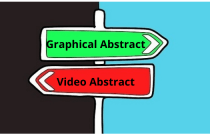Graphics, Videos and Tweets: New and Unconventional Abstract Formats

As scientific journals have migrated online and accessing articles digitally has become the norm for most readers of scientific research, various publishers have begun to explore new ways of presenting information. Recently, some journals have started to experiment with new digital technologies to create abstracts in different forms, moving away from the traditional 300 words of textual format. Their aim is to grab the attention of potential readers in innovative and unexpected ways. These new formats include graphical, video, readable, and tweetable abstracts.
Graphical Abstracts
Currently, graphical abstracts are perhaps one of the most extensively used formats, and their use is endorsed by Elsevier. A graphical abstract represents the findings of the article in a single image, which can be easily understood and conveys relevant information to the reader. Often these images are graphs that have been used in the articles, and sometimes they are specially created as an abstract, as can be seen below:

Etrych, T., et al., Biodegradable star HPMA polymer–drug conjugates: Biodegradability, distribution and anti-tumor efficacy, Journal of Controlled Release, 154, 3, 241-248: http://dx.doi.org/10.1016/j.jconrel.2011.06.015.
Graphical abstracts aim to help readers understand the article and assess its relevance to their own work without having to examine the complete article. However, some critics have described graphical abstracts as confusing and difficult to decipher. They argue that graphical abstracts can be understood only by reading the article, which rather defeats the purpose!
Readable Abstracts
Readable abstracts aim to enhance the accessibility of scientific articles and increase the impact of scientific research to people outside the specific field of study by providing an overview of the content in a completely non-technical language. An ideal readable abstract is accessible to individuals directly. British Journal of Learning Disabilities uses this format and has termed it as an “Accessible Summary.” Readable abstracts allow individuals who do not have the technical expertise in a particular subject area to access and understand scientific research. This not only improves the experience for the reader, it also makes work in one field more easily available to those trained in allied but separate disciplines. Thus, interdisciplinary research is encouraged, relevance is increased, and it is more likely that the research will be read and cited.
Moreover, readable abstracts force the authors to write for and explain their research to different audiences, using language that is very different to the formal, precise academic tone used in journal articles. This is a useful skill for researchers as public engagement and open access becomes more important in the academic world.
Video Abstracts
Video abstracts are a novel way for researchers and publishers to increase the visibility as well as the impact of research to a global audience. A video abstract is around five minutes long and allows the author(s) to speak to potential readers, explaining their research, its contribution, as well as importance. Video abstracts are now supported by a number of publishers, including Elsevier and Taylor and Francis, and they aim to engage the audience using narratives in a simple language, relevant data, as well as visual graphics. Through a video, a lot of information can be shared using words, images and on-screen text very quickly; therefore, video abstracts allow more detail than a text abstract, but in a more accessible format.
Video abstracts aim to help authors significantly increase the visibility of their newly published research and also increase both the citation numbers and impact of their overall research. In addition, video abstracts are also useful for early-stage researchers and graduate students to quickly understand the impact of a particular study. Several examples of accessible and easy to follow video abstracts for articles can be seen in the New Journal of Physics.
Tweetable Abstracts

Tweetable abstracts explain the results and importance of the research studies in 120-140 characters and are used for posting a newly published study on Twitter. Considering the immediate reach of such tweets to a wide audience, such abstracts have helped improve the visibility of research on a real-time basis via social media. Such abstracts are considered to be very effective in the dissemination of research. These abstracts were first introduced by the online-only journal of the British Ecological Society, Methods in Ecology and Evolution. They currently maintain a very active Twitter account with almost 10,000 followers.







